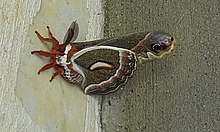Attacin
Attacin is a glycine-rich protein of about 20 kDa belonging to the group of antimicrobial peptides (AMP). It is active against Gram-negative bacteria.[1]
| Attacin | |
|---|---|
 The silk moth, Hyalophora cecropia | |
| Identifiers | |
| Symbol | Attacin, Att |
| InterPro | IPR040428 |
Attacin was first discovered in Hyalophora cecropia,[2][3] but is widely conserved in different insects from butterflies to fruit flies.
See also
- Diptericin, a structurally related antimicrobial peptide[4]
References
- Imler JL, Bulet P (2005). "Antimicrobial Peptides in Drosophila: Structures, Activities and Gene Regulation". Antimicrobial peptides in Drosophila: structures, activities and gene regulation. Chemical Immunology and Allergy. Chemical Immunology and Allergy. 86. pp. 1–21. doi:10.1159/000086648. ISBN 978-3-8055-7862-2. PMID 15976485.
- Hultmark D, Engström A, Andersson K, Steiner H, Bennich H, Boman HG (1983). "Insect immunity. Attacins, a family of antibacterial proteins from Hyalophora cecropia". The EMBO Journal. 2 (4): 571–6. doi:10.1002/j.1460-2075.1983.tb01465.x. PMC 555063. PMID 6628360.
- Lee JY, Edlund T, Ny T, Faye I, Boman HG (1983). "Insect immunity. Isolation of cDNA clones corresponding to attacins and immune protein P4 from Hyalophora cecropia". The EMBO Journal. 2 (4): 577–81. doi:10.1002/j.1460-2075.1983.tb01466.x. PMC 555064. PMID 6628361.
- Hedengren M, Borge K, Hultmark D (December 2000). "Expression and evolution of the Drosophila attacin/diptericin gene family". Biochemical and Biophysical Research Communications. 279 (2): 574–81. doi:10.1006/bbrc.2000.3988. PMID 11118328.
This article is issued from Wikipedia. The text is licensed under Creative Commons - Attribution - Sharealike. Additional terms may apply for the media files.